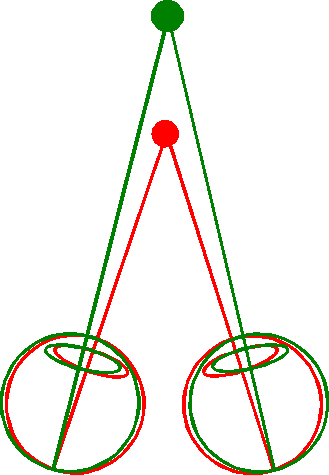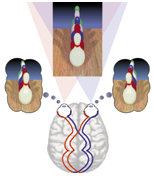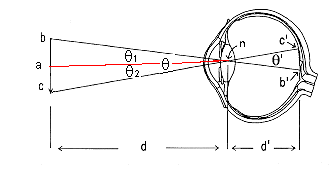Depth of (object) field and depth of (image) focus
Definition: The range of object distances for which the circles of confusion are so small that the image is sharp enough to be considered 'in focus' is called the depth of field. Definition:The range of image distances over which the image of an improperly focused object is acceptably sharp is called the depth of focus. Definition: The circle of confusion is the area of the retina over which the cells are stimulated by light from a point on an object. The bigger tthe circle, the more blurred the point becomes. The maximum acceptable circle of confusion determines the depth of field and focus of an eye. Decreasing the pupil size: increases both the depth of field and the depth of focus.
An eye cannot focus on objects that are at different distances from it at the same time. Therefore strictly speaking once the eye has accomodated (adjusted the strength of the eye-lens) to view an objact at an object distance O from it, it should only be able to see objacts that are that precise distance away in focus. However, if the object is almost that distance away the object forms an image which is acceptably sharp enough for the barain of the observer to make out enough detail for him/her to class it as in focus. The depth of field deals with the range of 'acceptable' object distances that can be classed as 'in focus' when it is accomodated to focus on a particular spot. The diagram below shows light from a point object at 0 brought to a focus at I on the retina. click on the image to enlarge it Light from objects at O1 and O2, is out of focus (but acceptably so!) and, in each case, covers a circular area of the retina with a diameter XY instead of being a point image. This is known as the circle of confusion. The range of object distances for which the circles of confusion are so small that the image is sharp enough to be considered 'in focus' is called the depth of field. So if XY is the diameter of the largest acceptable circle of confusion, the depth of field is the distance between O1 and O2,. Therefore ALL objects placed between O1 and O2 would be considered to be in focus by the viewer. click on the image to enlarge it Decreasing the size of the pupil (as would happen automatically when viewing an object in bright light conditions) increases the depth of field because it decreases the diameter of the circle of confusion - X'Y'the diagram above is smaller than in XY. This means that O1 and O2 could be further apart and the eye would still class the image as 'sharp enough'. The
depth of field is much greater for distant objects than for nearby objects.
This is because any given change in object distance has a greater effect
on Not only do our pupils get smaller in brigher light conditions they also get smaller as we concentrate on ever closer objects. This constriction therefore offsets (to some extent) the decreased depth of field we get when viewing closer objects..
click on the image to enlarge it Decreasing the size of the pupil increases the depth of focus. Depth
perception - click on link Monocular (One eye)
vision The brain also uses the overlapping of distant objects by near ones, shadows, reflections, and the way colour appears different (distant objects appear more blue) to interpret depth in a stationary scene - artists use the same techniques to give depth to their pictures. When you move your head, images of close objects move across the retina faster' than those of distant objects. This 'moving parallax' effect is another mechanism that is used by the brain to apply depth perception in monocular vision. Using two eyes instead of one results in larger visual field results. The blind spot and any disorder of one eye is not critical, and a vastly improved depth perception is gained. This is because of:
The ability of the
eye to distinguish between two objects at different distances depends
on the difference in the visual angle subtended by the two objects, the
minimum discernible angle being about half a minute (remember there are
sixty minutes in a degree!). Hence, depth perception decreases with distance,
vanishing altogether beyond a certain distance (the stereoscopic range)
which is normally about 60 m. If you look at the diagram on the left and consider the tiny size of d' compared to d you can appreciate how small angle q will be.
|
Follow me...
|


 convergence
- the visual axes automatically converge on the object studied thus
permitting a judgement of distance.When you look at objects that are
very far away your two eyes point very nearly straight ahead. As objects
come closer (less than about 6 meters or so) your eyes will noticeably
turn in (converge). The nearer objects are to you the more your eyes
will turn towards your nose. This eye position is called convergence.
convergence
- the visual axes automatically converge on the object studied thus
permitting a judgement of distance.When you look at objects that are
very far away your two eyes point very nearly straight ahead. As objects
come closer (less than about 6 meters or so) your eyes will noticeably
turn in (converge). The nearer objects are to you the more your eyes
will turn towards your nose. This eye position is called convergence. stereopsis
stereopsis



